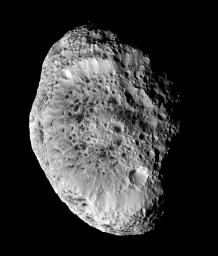Saturn's impact-pummeled Hyperion stares back at Cassini
in this six-image mosaic taken during the spacecraft’s close
approach on Sept. 26, 2005.
This up-close view shows a low density body blasted by
impacts over the eons. Scientists originally believed that the
spongy appearance of Hyperion is caused by a phenomenon
called thermal erosion, in which dark materials accumulating
on crater floors are warmed by sunlight and melt deeper into
the surface, allowing surrounding ice to vaporize away.
Cassini scientists now think that Hyperion’s unusual appearance
can be attributed to the fact that it has an unusually low density
for such a large object, giving it weak surface gravity and high
porosity. These characteristics help preserve the original shapes
of Hyperion’s craters by limiting the amount of impact ejecta
coating the moon’s surface. Impactors tend to make craters by
compressing the surface material, rather than blasting it out. Further,
Hyperion’s weak gravity, and correspondingly low escape velocity,
means that what little ejecta is produced has a good chance of
escaping the moon altogether.
At 280 kilometers, (174 miles) across, Hyperion’s impact-shaped
morphology makes it the largest of Saturn's irregularly-shaped moons.
Six, clear-filter images were combined to create this mosaic. Images
were taken by the Cassini spacecraft narrow-angle camera at a mean
distance of about 33,000 kilometers (20,500 miles) from Hyperion and
at a sun-Hyperion-spacecraft, or phase, angle of 51 degrees. Image
scale is 197 meters per pixel.
The Cassini-Huygens mission is a cooperative project of NASA, the European
Space Agency and the Italian Space Agency. The Jet Propulsion Laboratory,
a division of the California Institute of Technology in Pasadena, manages
the mission for NASA's Science Mission Directorate, Washington, D.C. The
Cassini orbiter and its two onboard cameras were designed, developed and
assembled at JPL. The imaging operations center is based at the Space
Science Institute in Boulder, Colo.
For more information about the Cassini-Huygens mission visit
http://saturn.jpl.nasa.gov. The Cassini imaging team homepage is at
http://ciclops.org.

 Planetary Data System
Planetary Data System












